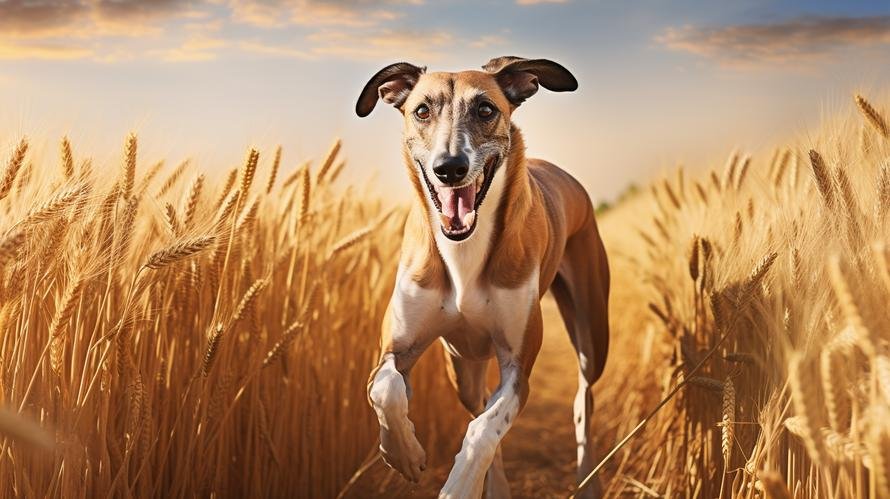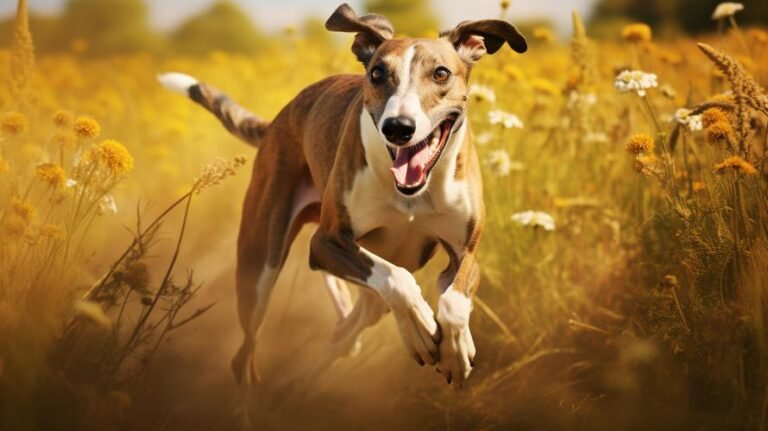Imagine a cheetah-like dog that zooms past you with sleek grace, a lean physique, and eye-catching elegance. Envision a canine so speedy, it could almost outpace your car on a casual drive around the block. Meet the Greyhound—the Formula 1 racer of the dog world!
Now, speed is thrilling, but alongside visions of this lightning-fast pooch, does the idea of a high-maintenance, hard-to-handle pet also race through your mind? Let’s dispel some myths and track the truth about Greyhounds—ease your seatbelt, because this discovery journey promises to be as smooth as a Greyhound’s gait.
First, if your thoughts about Greyhounds are limited to racetracks and swift chases, let’s expand the circuit. Greyhounds, one of the oldest purebred canines, were originally bred as hunting dogs due to their keen sight and phenomenal speed. However, these same characteristics made them superstars on the racing scene. But here’s the catch: Greyhounds aren’t all about relentless energy and round-the-clock activity.
In fact, Greyhounds are often likened to couch potatoes. Yes, you read that right! When they’re not bolting in a blur of fur, these dogs love to lounge. Greyhounds enjoy sprawling out on the sofa and dozing off for hours, earning them the nickname “45 mph couch potatoes.” They treasure a good nap as much as they delight in a brisk sprint.
Concerned about space for a Greyhound to stretch its legs in your living area? Despite their athleticism, Greyhounds don’t require a mansion-sized home. They generally adapt well to different living environments, including apartments, because of their calm indoor demeanor. Nevertheless, they will need a safe place to run full throttle every once in a while. If you have a fenced yard or access to a secure off-leash area, that’ll do nicely! Just remember, their speed is matched by their love for chasing, so a fence is a must to prevent any runaway adventures.
Next on the list of misconceptions is trainability. Some might think a dog bred for chasing and racing would be difficult to train. On the contrary, Greyhounds are keen learners. With positive reinforcement and consistent training sessions, Greyhounds can pick up commands and become well-mannered pets. They’re sensitive souls though; harsh words aren’t necessary. Treats, gentle guidance, and patience will help your Greyhound understand what you’re asking of them.
Healthwise, Greyhounds are generally robust, but they have some quirks. Their lean frame means they don’t have much body fat, which translates to a couple of things. First, they can be sensitive to cold and might need a cozy coat for winter walks. Second, most forms of common anesthesia can be risky for these slim speedsters due to their low body fat, so it’s vital to find a vet experienced with sighthounds if surgical procedures are ever needed.
Greyhounds are friendly but sometimes aloof. They might not rush to greet every visitor with tail-wags and kisses, but they bond deeply with their families. Their gentle and quiet nature makes them excellent companions for those who appreciate a calm, unobtrusive pet. However, don’t be surprised if your Greyhound decides to shadow you around the house – they’re known for forming a strong attachment to their humans.
For families with young children, Greyhounds can be a good fit if the kids understand how to interact gently with dogs. Their tolerant and less excitable nature is a plus, although, as with any dog, supervision and education on how to respect a pet’s space are important.
What about the company of other pets, particularly smaller ones? Greyhounds have a prey drive, but that doesn’t mean they can’t coexist with cats, rabbits, or other small pets. Introductions should be done carefully and supervised to ensure everyone gets along. Many Greyhounds live peacefully with a variety of animal siblings; it’s about the individual dog and proper socialization.
Sometimes Greyhounds come into homes as retirees from the racing world. Adopting a retired racer can be a rewarding experience. These dogs often transition well into pet life, relishing the opportunity to settle down in a comfy home. Plenty of support is available to guide you through this process, with rescue groups specializing in rehoming these graceful athletes.
If you’re considering bringing a Greyhound into your life, be prepared for heartwarming moments and lightning-fast licks. They’re magnificent creatures that capture hearts with their gentle eyes, quirky grins, and love of life. While Greyhounds are not difficult dogs, they’re unique and require an understanding of their specific needs.
Choosing a Greyhound means gaining a loyal friend who’s as cool with chilling out as they are with hitting top speeds. They’re not too complicated; they just need love, understanding, and the occasional chance to stretch their legs in a safe environment. With the right care, a Greyhound can sprint right into your heart and curl up there for good.
So, there you have it—the intricate mosaic of the Greyhound. With keen insight, you can now see beyond the misconception of a high-strung sprinter to the true picture: a serene, adaptable, and loving pet that may bring elegance and joy into your home at a gentle trot or an exuberant run. If you’re ready for a pet that embodies grace both in motion and in repose, the Greyhound might just be your perfect companion on life’s track.



